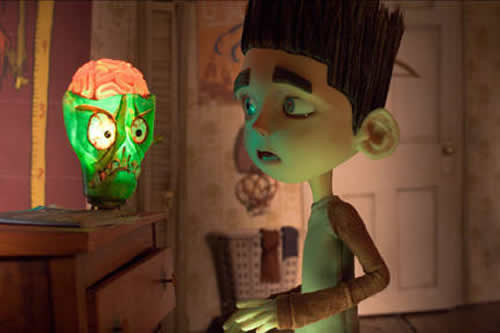
Zombos Says: Good
Two thoughts pushed their way to the top after I saw Ole Bornedal's The Possession. The first was how much less frightening the dybbuk demon is than Pazuzu in The Exorcist: I find that evil, when it's personable, when it speaks directly to you in a normal, conversational fashion, is more terrifying than the silent type. The second thought was how Bornedal's beautifully moving camera, along with Anton Sanko's suitably depressing piano tinkling heralding austere, fade to black, moments, fairly killed the story's momentum. Antiseptic, plain vanilla, no contrast, these are some of the words I would use to describe how the story unfolds. This is still a good movie, mostly due to Jeffrey Dean Morgan's intensity as Clyde, a father who slowly realizes the truth, Natasha Calis's sinister behavior as the possessed girl, Em, and a delectably creepy hint of a backstory for the wooden box that traps the dybbuk (or fails to). This is the kind of movie I found myself wishing they'd stuck with that backstory because the present is comprised of moments we've, mostly, seen before (and were done with more con brio when we did). Except for that exquisitely bad to the bone looking box.
It not only looks old but it looks like one you'd fear was full of dark secrets. Its contents are even more bizarre than the ones seen on that cable show Oddities. It made me wonder what its oddly shaped jars contained and why those contents were put there, and especially how the dybbuk was trapped the first time. Instead, we see the diagnostic-tests-at-the-hospital scene, although this one does provide the scariest moment of the movie with a brightly conceived visual; and, of course, there's the now standard family situation to generate budget tension--mom (Kyra Sedgewick) and dad are divorced and mom has an annoying suitor (Grant Show); and, of course, there are langorous scenes of bodily invasion, like moths flying in and out of mouths. What is it with winged bugs and possessing demons? Can someone, anyone, please give me an explanation for their overuse in horror movies and their preference for oral cavities?
Picking up the box at a yard sale, Em opens it and the possession begins with her becoming more and more Goth in appearance (no offence to Goths or Emos intended, but hey, it's a spooky look). Em also puts on a large, hard to miss, ring, which turns her hand all veiny and purple. Her parents and sister don't seem to notice. Another reviewer noted how odd it is that neither parent notices the purpling hand or the Victorian nut-cracker of a ring. Dracula wished he had a ring like that.
The usual quirky behavior of the new man in Clyde's ex-wife's life provides the usual banter and time-filler between more serious moments with Em being sucked dry of life by the demon. Bornedal is so visually artistic and thematically structured in his approach, however, there's no meat on this horror bone. Comparison's to The Exorcist, and other possession movies, are inevitable. Where Bornedal brings a fresh take is when he jostles Clyde's predictable, coaching-life world alongside an older, steeped in tradition, Hasidic world in Brooklyn as Clyde seeks help from the experts, who in this case are the rabbis.
They see the box and tell him to take a hike, with it. A brilliant and unexpected move. In The Exorcist, the priests tackle Pazuzu as a matter of faith and conviction. And both priests do not survive the ordeal. Here, the rabbis choose survival first, knowing what's in the box is serious enough to warrant being in the box. The head rabbi's son, Tzadok (Matisyahu), still retains his faith and conviction: he's young, what does he know? He leaves with Clyde and both must do one thing first: find out what the demon's name is because that is what's needed to force the demon back into the box.
The name is found a little too quickly, but it leads to the showdown between the rabbi's son with conviction, the father with conviction, the mom with conviction, and the demon with conviction. Bornedal doesn't ignite enough hell fire though, and compromises the showdown by resorting to strobe-lighting views as the demon pulls itself out of someone's mouth (there's that foreign object in mouth again theme: see the movie poster) and crawls along the floor, reluctantly, toward the box. Stylish? Yes. Dramatically hot? No; tepid. Terrifying? A little.
The ending follows the prescribed sequel-antic expected for generating a horror movie franchise. I doubt, however, this box will turn up again unless it's straight to DVD.























